英国文学简介--General Introduction to British Literature
- 格式:ppt
- 大小:5.49 MB
- 文档页数:57
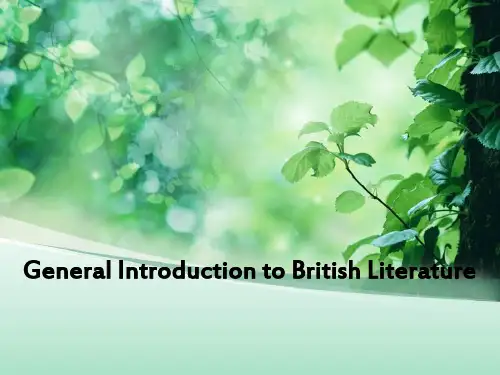
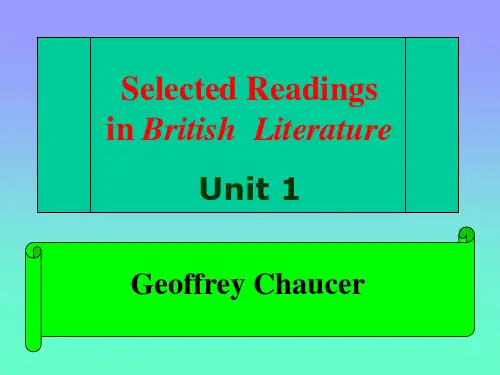
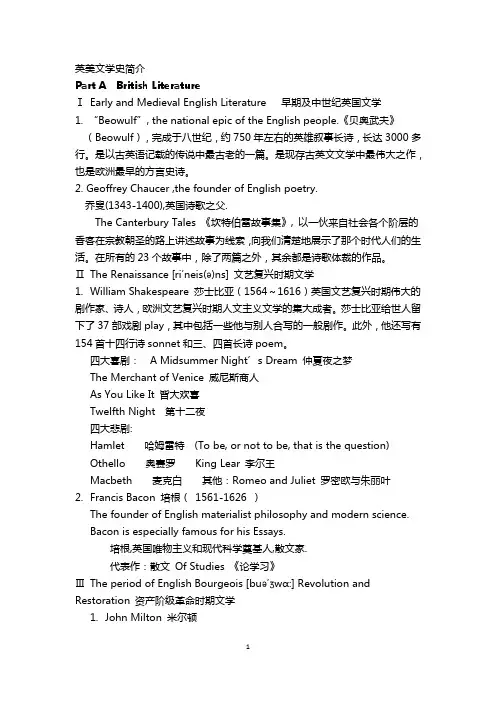
英美文学史简介Part A British LiteratureⅠEarly and Medieval English Literature 早期及中世纪英国文学1. “Beowulf”, the national epic of the English people.《贝奥武夫》(Beowulf),完成于八世纪,约750年左右的英雄叙事长诗,长达3000多行。
是以古英语记载的传说中最古老的一篇。
是现存古英文文学中最伟大之作,也是欧洲最早的方言史诗。
2. Geoffrey Chaucer ,the founder of English poetry.乔叟(1343-1400),英国诗歌之父.The Canterbury Tales 《坎特伯雷故事集》, 以一伙来自社会各个阶层的香客在宗教朝圣的路上讲述故事为线索,向我们清楚地展示了那个时代人们的生活。
在所有的23个故事中,除了两篇之外,其余都是诗歌体裁的作品。
ⅡThe Renaissance [ri′neis(ə)ns] 文艺复兴时期文学1.William Shakespeare 莎士比亚(1564~1616)英国文艺复兴时期伟大的剧作家、诗人,欧洲文艺复兴时期人文主义文学的集大成者。
莎士比亚给世人留下了37部戏剧play,其中包括一些他与别人合写的一般剧作。
此外,他还写有154首十四行诗sonnet和三、四首长诗poem。
四大喜剧: A Midsummer Night’s Dream 仲夏夜之梦The Merchant of Venice 威尼斯商人As You Like It 皆大欢喜Twelfth Night 第十二夜四大悲剧:Hamlet 哈姆雷特(To be, or not to be, that is the question)Othello 奥赛罗King Lear 李尔王Macbeth 麦克白其他:Romeo and Juliet 罗密欧与朱丽叶2.Francis Bacon 培根(1561-1626 )The founder of English materialist philosophy and modern science.Bacon is especially famous for his Essays.培根,英国唯物主义和现代科学奠基人,散文家.代表作:散文Of Studies 《论学习》ⅢThe period of English Bourgeois [buə′ʒwɑ:] Revolution and Restoration 资产阶级革命时期文学1.John Milton 米尔顿Paradise Lost 《失乐园》2. John Bunyan 班扬The Pilgrim’s Progress 《天路历程》ⅣEighteenth Century English Literature 十八世纪英国文学1. Daniel Defoe: 笛福Robinson Crusoe 《鲁滨逊漂流记》2. Jonathan Swift:斯威夫特Gulliver’s Travels 《格列佛游记》3. Henry Fielding 菲尔丁the Founder of the English Realistic Nov 英国现实主义小说奠基人Joseph Andrew 《约瑟夫·安德鲁》4. William Blake 布莱克and Robert Burns彭斯: PoetⅤRomanticism in England 浪漫主义时期文学1. William Wordsworth 华滋华斯the representative poet of the early romanticism. 标志着浪漫主义的开始2. George Gordon Byron 拜伦Don Juan 《唐·璜》3. Percy Bysshe Shelley 雪莱Prometheus Unbound《解放了的普罗米修斯》If winter comes, can spring be far behind? 冬天来了,春天还会远吗?4. John Keats 济慈Ode to a Nightingale 《夜莺颂》5. Jane Austen 简·奥斯汀Pride and Prejudice 《傲慢与偏见》ⅥThe Victorian Age 维多利亚时期文学1. Charles Dickens 狄更斯代表作:Oliver Twist 《雾都孤儿》、A Tale of Two Cities《双城记》、David Copperfield 《大卫·科波菲尔》2. William Makepeace Thackeray 萨克雷代表作:Vanity Fair 《名利场》3. George Eliot 乔治·艾略特4. The Brontë Sisters 勃朗特三姐妹Charlotte Brontë夏洛蒂·勃朗特:Jane Eyre《简·爱》Emily Brontë艾米莉·勃朗特:Wuthering Heights 《呼啸山庄》Annie Brontë安妮·勃朗特5. The Brownings 勃朗宁夫妇Husband: Robert BrowningWife: Elizabeth BrowningSonnets from the Portuguese 《葡语十四行诗集》ⅦTwentieth Century English Literature 20世纪英国文学1. Thomas Hardy 托马斯·哈代Tess of the d’Urbervilles《德伯家的苔丝》2. John Galsworthy 高尔斯华绥3. Oscar Wilde 王尔德Poet,dramatist, novelist and essayist.The Happy Prince and Other Tales 《快乐王子和其他故事》4. George Bernard Shaw 萧伯纳the most important English dramatist5. D. H. Lawrence 劳伦斯Lady Chatterley’s Lover 《查泰来夫人的情人》6. Virginia Woolf 伍尔芙Feminism, the stream of consciousness意识流女权主义与现代主义小说的先驱7. James Joyce 乔伊斯Ulysses《尤里西斯》the stream of consciousness意识流Part B American LiteratureⅠThe Literature During the Colonial American and the American Revolution殖民地时期及独立战争时期的文学Benjamin Franklin 本杰明·富兰克林ⅡAmerican Romanticism and New England Literature 浪漫主义及新英格兰时期文学1. Washington Irving华盛顿•欧文(1783-1859)the first American to achieve an international literary reputation. 是美国文学的奠基人之一。
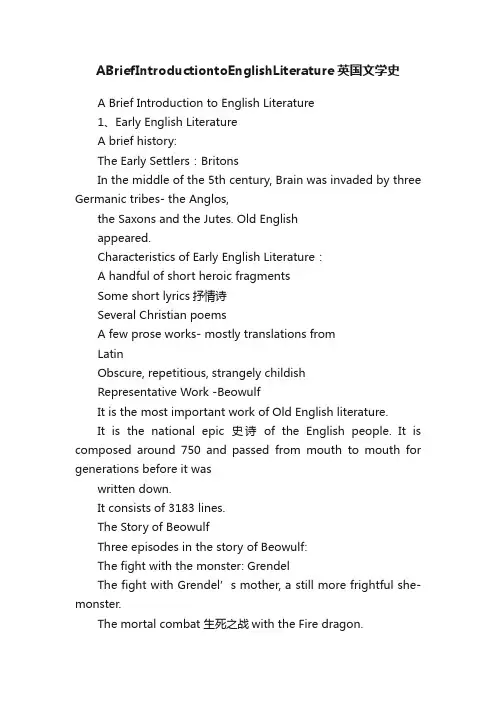
ABriefIntroductiontoEnglishLiterature英国文学史A Brief Introduction to English Literature1、Early English LiteratureA brief history:The Early Settlers:BritonsIn the middle of the 5th century, Brain was invaded by three Germanic tribes- the Anglos,the Saxons and the Jutes. Old Englishappeared.Characteristics of Early English Literature:A handful of short heroic fragmentsSome short lyrics抒情诗Several Christian poemsA few prose works- mostly translations fromLatinObscure, repetitious, strangely childishRepresentative Work -BeowulfIt is the most important work of Old English literature.It is the national epic史诗of the English people. It is composed around 750 and passed from mouth to mouth for generations before it waswritten down.It consists of 3183 lines.The Story of BeowulfThree episodes in the story of Beowulf:The fight with the monster: GrendelThe fight with Grendel’s mother, a still more frightful she-monster.The mortal combat 生死之战with the Fire dragon.The ideals of the ancient British People:Valor勇猛, the love of glory; honor, duty, loyalty and the generosity.The vivid portrayal of a great national hero who is brave, courageous, selfless, and ever helpfulto his people and his kinsfolk.Language features of Beowulf: The use of alliteration“Thus joined the m en of the Geats in m ourningTheir h ero’s end. His h earth-companionsCalled him the best among the kings of the earthK indest to k insmen and k eenest for fame.”The use of metaphors and understatements Metaphor:King: ring-giverAttendant warrior: hearth companionsSea: s wan’s path; whale’s roadSolider: shield-bearer; spear-fighterUnderstatement:Very welcome: not troublesomeCondemn: deed not praise(gives an impression of reserve and at times a tinge of ironical humor.)A mixture of pagan 异教徒and Christianelements:For example:Blood-revenge; the praise of worldly glory (pagan)The existence of Heaven and Hell (Christian)2、The Middle English Literature(1066-1485)Historical Background:The Norman Conquest:In 1066 England was conquered by the Normans lead by William the Conqueror, Duke of Normandy.The Normans brought with them their social organization, new laws and new speech.French became the dominant language at that time, and English was only spoken by people of lower classes.The century and a half after the Conquest, English literature almost stood still. It wasn’t until the 14th century that the Middle English literature began to awake.Forms of Middle English LiteraturePoemsKing Arthur and His Knights of the Round Table Popular Ballads民谣Robin HoodMedieval dramamiracle playsmorality playsInterludes幕间幽默短剧Representative WorkThe Canterbury Tales by Geoffrey ChaucerThe Canterbury Tales presents before the reader a panoramic 全景的view of the Medieval life.(1)Chaucer is an artist. His poem is rich in musicand elegant to a very high degree.(2)He is a keen observer of life.(3)The characters in his tales are most vividlydrawn.(4)He sympathizes with true piety and goodnessand attacks severely the hypocritical伪善的人.(5)He is a master of satire. The fusion of humorwith satire is the basic note of his style.Chaucer’s Contribution to English Literature (1)He introduced from France and Italy the rhymedstanzas of various forms to English poetry. (2)He is the first poet who wrote in current Englishlanguage.3、The English Renaissance Renaissance Literature (1485-1660)“Renaissance” means “Rebirth”--Rebirth of interest in the Greek and Latin classicsCharacteristics:(1)Emphasis on humanistic education forstatesmanship政治才能.(2)Focus on the individual and a concern with thefullest possible cultivation of human potentialthrough proper education; focus on individualconsciousness and the Interior mind(3)Concern with the refinement of the language andthe development of a national literatureThree Stages of the English RenaissanceThe Beginning (1485-1558)The Elizabethan Age (1558-1603)The Seventeenth Century (1603-1660)The Beginning of the English Renaissance (1485-1558)The Oxford ReformersThey were students and later teachers at Oxford University. They traveled and studied in Italy, introduced classical literature to England and tried to reform education on a humanistic line.The Elizabethan Age(1558-1603)The Age of ShakespeareIt is the peak of the English Renaissance, and is considered the most creative period in thehistory of English literature. A golden age.Famous names at that time:–Edmund Spencer–Christopher Marlowe–Ben Johnson–Francis Bacon–William ShakespeareEdmund Spencer(1552-1599)Spencer was called the “poets’ poet” because of his superb technical skills, perfect melodies, rare sense of beauty, splendid imagination, lofty moral purity and seriousness, and delicate idealism.Representative Work:The shepherd’s CalendarFrancis Bacon (1561-1626)The most important prose writer. The first English essayist.Some Essays Written by BaconOf studyOf friendshipOf beautyOf loveOf envyOf revengeOf travelOf Marriage and single lifeOf Parents and KidsQuotes From Bacon’s WorksKnowledge is powerIt is impossible to love and be wise.Natural abilities are like natural plants, that need pruning by study; and studiesthemselves do give forth directions toomuch at large, except they be bounded in byexperience.William Shakespeare (1564-1616)As the greatest English poet and dramatist, he left us a great wealth of 154 sonnets, 37 plays including 14 comedies, 12 tragedies and 11 historical plays, as well as 2 long poems.S ome of Shakespeare’s Great WorksThe Merchant of VeniceA Midsummer Night’s dreamThe TempestTwelfth NightRomeo and JulietJulius CaesarHamletOthelloKing Lear……Theme in Shakespeare’s PoemGood always overcame evil in the long run, and justice would eventually win its cause in the end. Love, faith, work and duty were the four elements that in all ages made the world right.Youth, love and ideal of happiness, as well as the victory of the humanist ideal after severe struggle against all obstacles.The heroes and heroines fight against destiny itself andmould their own fate according to theirown will.There is an unconquerable contradiction between humanist ideals and terrible social realities. Chief Achievements and Characteristics of Shakespeare’s Dr amaThe progressive significance of his themes.His successful character portrayal.His master hand高超的技艺in constructing plays.The ingenuity巧妙of his poetryHis mastery of English Language.The Seventeen’s Century (1603-1660) Characteristics of this age:It has no unity of spirit as in the days of Elizabeth.Much of the literature of this period is somber in character. It saddens rather than inspires us. Itdoesn’t have the hopefulness and vigor of theprevious age.It has lost the romantic impulse of youth and become critical and intellectual.Representative WorkJohn Milton and His Paradise LostThe rebellion of Satan and his fellow angelsTheir defeat and expulsion from HeavenThe creation of the Garden of Eden and the first man and woman Adam and Eve ?The fallen angels in hell plotting against GodSatan’s temptation of EveThe exile of Adam and Eve from Paradise John Milton:The great poet and prose writer.4、The Eighteen’s Century Literature(1660-1798)The rise of the English novelDaniel Defoe and his Robinson Crusoe.5、The Age of Romanticism (1798-1832) Characteristics:(1)The Spontaneous Overflow of PowerfulFeelings(2)The creation of a world of Imagination(3)The Return for Nature for Material(4)Sympathy with the Humble and Glorificationof the Common-place(5) A sense of Melancholy and loneliness(6)The Rebellious SpiritRepresentative Works●William Wordsworth: Lyrical Ballads●Robert Burns: Red Red Rose●George Gordon Byron: When we two parted;She walks in Beauty●Percy Bysshe Shelley: Ode to the West Wind ●John Keats: Ode to a Nightingale6、The Victorian Age(1832-1901)Literature CharacteristicsVariety in style and subject matter.The flourishing of realistic novels.The memorable poetry of the “Big Three”: Tennyson, Browning and Arnold.The emergence of the Aesthetic美学的Movement, represented by Oscar Wilde. Representative WorksCharles Dickens (1812-1870)Oliver TwistDavid CopperfieldA Tale of Two CitiesGreat ExpectationsWilliam Makepeace Thackeray (1811-1863) Vanity FairGeorge Eliot (1819-1880)MiddlemarchCharlotte Bronte (1816-1855)Jane EyreThomas Hardy (1840-1928)Tess of the D’Urbervilles7、The Twentieth Century Literature Modernism:Radical and deliberate break from traditional forms. Symbolism; Impressionism; Stream of Consciousness Modernist Poets:Yeats and Eliot Characteristics of their poems:Direct treatment of things and avoidance of any unnecessary words.Freer metrical韵律的movementSymbolism in the poemsCloser to that of conversation by the use of colloquial expressions and even slangs.Frequent use of irony and puns Modernism NovelistHenry James (1843-1916)Daisy MillerPortrait of a LadyThe Emphasis is laid on how a character feels rather than how he acts, and the conflict are moved from the outside world to the inner world of the characters.Psychological NovelistD.H. Laurence (1885-1930)Sons and LoversThe RainbowA combination of psychological analysis and social criticism。
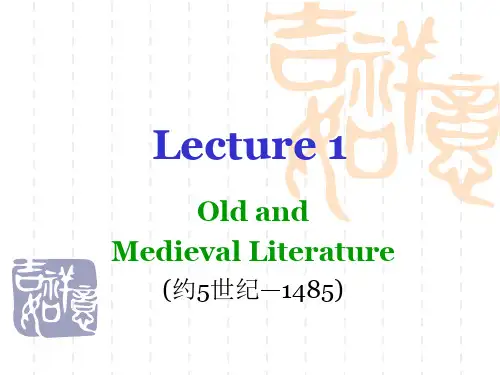

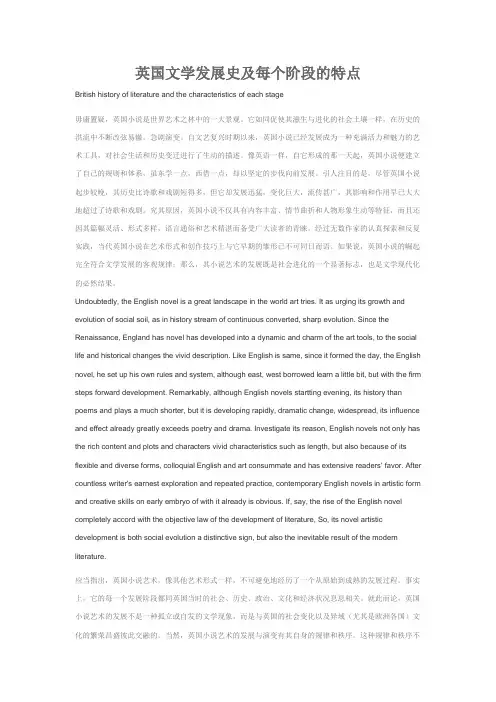
英国文学发展史及每个阶段的特点British history of literature and the characteristics of each stage毋庸置疑,英国小说是世界艺术之林中的一大景观。
它如同促使其滋生与进化的社会土壤一样,在历史的洪流中不断改弦易辙,急剧演变。
自文艺复兴时期以来,英国小说已经发展成为一种充满活力和魅力的艺术工具,对社会生活和历史变迁进行了生动的描述。
像英语一样,自它形成的那一天起,英国小说便建立了自己的规则和体系,虽东学一点,西借一点,却以坚定的步伐向前发展。
引人注目的是,尽管英国小说起步较晚,其历史比诗歌和戏剧短得多,但它却发展迅猛,变化巨大,流传甚广,其影响和作用早已大大地超过了诗歌和戏剧。
究其原因,英国小说不仅具有内容丰富、情节曲折和人物形象生动等特征,而且还因其篇幅灵活、形式多样,语言通俗和艺术精湛而备受广大读者的青睐。
经过无数作家的认真探索和反复实践,当代英国小说在艺术形式和创作技巧上与它早期的雏形已不可同日而语。
如果说,英国小说的崛起完全符合文学发展的客观规律;那么,其小说艺术的发展既是社会进化的一个显著标志,也是文学现代化的必然结果。
Undoubtedly, the English novel is a great landscape in the world art tries. It as urging its growth and evolution of social soil, as in history stream of continuous converted, sharp evolution. Since the Renaissance, England has novel has developed into a dynamic and charm of the art tools, to the social life and historical changes the vivid description. Like English is same, since it formed the day, the English novel, he set up his own rules and system, although east, west borrowed learn a little bit, but with the firm steps forward development. Remarkably, although English novels startting evening, its history than poems and plays a much shorter, but it is developing rapidly, dramatic change, widespread, its influence and effect already greatly exceeds poetry and drama. Investigate its reason, English novels not only has the rich content and plots and characters vivid characteristics such as length, but also because of its flexible and diverse forms, colloquial English and art consummate and has extensive readers' favor. After countless writer's earnest exploration and repeated practice, contemporary English novels in artistic form and creative skills on early embryo of with it already is obvious. If, say, the rise of the English novel completely accord with the objective law of the development of literature, So, its novel artistic development is both social evolution a distinctive sign, but also the inevitable result of the modern literature.应当指出,英国小说艺术,像其他艺术形式一样,不可避免地经历了一个从原始到成熟的发展过程。
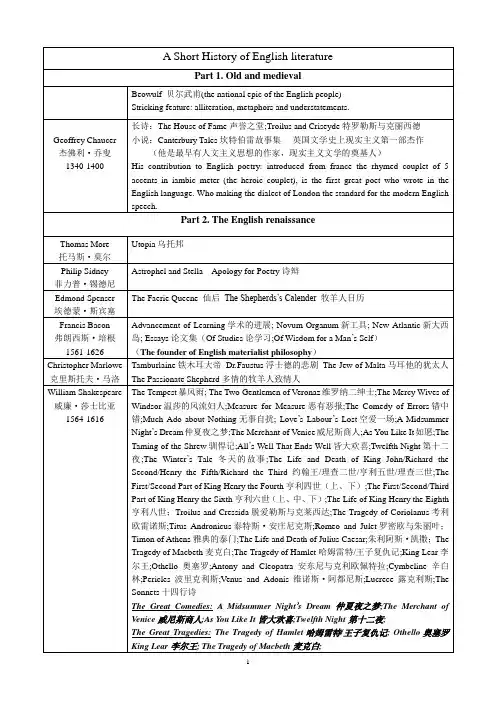
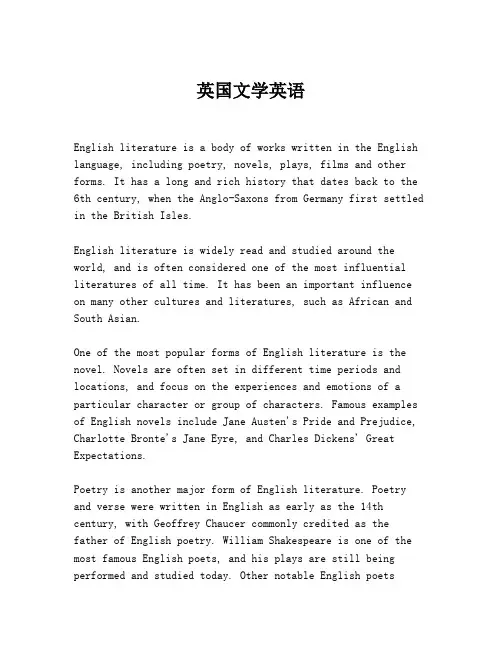
英国文学英语English literature is a body of works written in the English language, including poetry, novels, plays, films and other forms. It has a long and rich history that dates back to the 6th century, when the Anglo-Saxons from Germany first settled in the British Isles.English literature is widely read and studied around the world, and is often considered one of the most influential literatures of all time. It has been an important influence on many other cultures and literatures, such as African and South Asian.One of the most popular forms of English literature is the novel. Novels are often set in different time periods and locations, and focus on the experiences and emotions of a particular character or group of characters. Famous examples of English novels include Jane Austen's Pride and Prejudice, Charlotte Bronte's Jane Eyre, and Charles Dickens' Great Expectations.Poetry is another major form of English literature. Poetry and verse were written in English as early as the 14th century, with Geoffrey Chaucer commonly credited as thefather of English poetry. William Shakespeare is one of the most famous English poets, and his plays are still being performed and studied today. Other notable English poetsinclude John Donne, Emily Dickinson, and W. B. Yeats.English literature also includes a wide variety of drama, from commedia dell'arte and Elizabethan theater to contemporary Broadway shows. Notable English playwrights include William Shakespeare, George Bernard Shaw, Samuel Beckett, and Tom Stoppard.In the 20th century, English literature underwent a major shift with the rise of modernism. Novelists like Virginia Woolf and T. S. Eliot wrote works that explored new themes, techniques, and literary styles. Other innovators such as James Joyce, D. H. Lawrence, and William Faulkner also contributed to the development of modernist literature.Today, English literature continues to be studied, analyzed, and enjoyed by people around the world. It is a valuable source of historical and cultural knowledge, and a testament to the creativity and imagination of its writers and readers.。
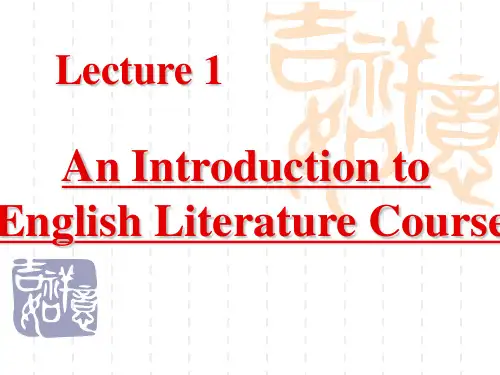
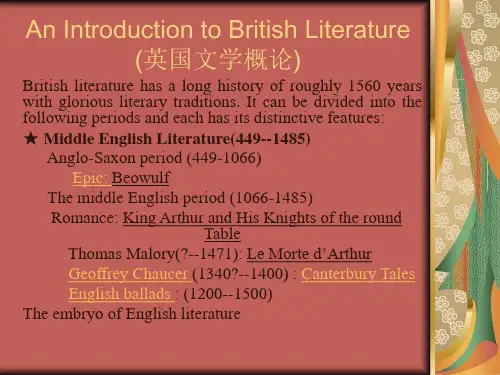
简爱简介篇一:简爱每章梗概主要内容1.简·爱的父亲是个穷牧师,当她还在幼年时,父母就染病双双去世。
简·爱被送到盖茨黑德庄园的舅母里德太太家抚养,里德先生临死前曾嘱咐妻子好好照顾简·爱。
简·爱在里德太太家的地位,连使女都不如,受尽了表兄表姊妹的欺侮。
2.一天表兄约翰又打她了,她回手反抗,却被舅母关进红房子里,她的舅舅里德先生就死在这间屋子里。
3——5.她被幻想中的鬼魂吓昏了过去。
重病一场,过了很久才慢慢恢复健康。
她再也不想呆在里德太太家了,里德太太就把她送进洛伍德孤儿院。
孤儿院院长勃洛克赫斯特是个冷酷的伪君子,他用种种办法从精神和肉体上摧残孤儿。
6——9.简·爱与孤儿海伦结成好友,教师谭波尔小姐很关心她。
在孤儿院里一场传染性的伤寒,夺走了许多孤儿的生命,海伦就在这场伤寒中因肺炎死去,这对简·爱打击很大。
10——11.简毕业后留校当了两年教师,她受不了那里的孤寂、冷漠,登广告找到了一个家庭教师的工作,于是她来到了桑菲尔德庄园。
12.简·爱来到桑菲尔德,一切就很平静。
一天,她去干草村送信,遇见了正在回来的路上的罗切斯特先生,初次见到简·爱的罗切斯特从马上摔了下来,回到家后,觉得很尴尬。
13.在桑菲尔德庄园只有庄园主罗切斯特和他的养女阿黛尔,而罗切斯特经常到国外旅行,所以简·爱到桑菲尔德好几天也没见到罗切斯特。
14.罗切斯特是个性格阴郁而又喜怒无常的人,他和简·爱经常为某种思想辩论不休。
15.在桑菲尔德庄园不断发生奇怪的事情。
有一天夜里,简·爱被一阵奇怪的笑声惊醒,发现罗切斯特的房门开着,床上着了火,她叫醒罗切斯特并扑灭火。
罗切斯特告诉简·爱三楼住着一个女裁缝格雷斯·普尔,她神精错乱,时常发出令人毛骨悚然的狂笑声,并要她对此事严守秘密。
16.当罗切斯特的房间着火之后,大家都因为(他)没有被烧死而庆幸,罗切斯特先生要出远门,去埃希敦先生家里。
English Literature: A ReviewPre-Renaissance Period:Beowulf, the first national epic of England:alliteration, metaphor and understatement.Norman Conquest in 1066 marked the establishment of feudal society in England, and William the conqueror passed the Doomsday book, and the conquest also started the dominance of French in England as the official language for more than 200 years.The class conflict in feudal England became so severe that in 1381 there was a great peasant rising.Romance became a dominant literary form in feudal England for the lords, and the chief representative work of this genre is King Arthur and His Knights of the Round Table. The definition can be briefly summed us as ―Any imagination literature that is set in an idealized world and that deals with a heroic adventures and battles between good characters and villains or monsters,‖ and a term is closely associated with Romance of this period, that is Chivalry. The Arthur Series ended with Malory‘s Le Morte D’Arthur.Ballad is the major literary genre for the peasants, and the most popular work is Robin Hood Series. The definition is ―A story told in verse and usually meant to be sung. In many countries, the folk ballad was one of the earliest forms of literature. Folk ballads have no known authors. They were transmitted orally from generation to generation and were not set down in writing until centuries after they were first sung. The subject matter of folk ballads stems from the everyday life of the common people. Devices commonly used in ballads are the refrain, incremental repetition, and code language. A later form of ballad is the literary ballad, which imitates the style of the folk ballad.‖Langland is said to be the author of Piers the Plowman.Chaucer: founder of English poetry, introduced Heroic Couple into English literature and also the first major poet to write in English. He also did a lot in standardizing English the language by using London dialect in his works. His major works are Troilus and Criseyde, The canterbury Tales.Thomas More: Utopia《乌托邦》Francis Bacon: Essays《论说文集》或《随笔》:―Knowledge is power‖----Bacon Edmund Spencer: Faerie Queen《仙后》―Our sweetest songs are those that sing of saddest feelings.‖ --- Spencer―Ode to the West Wind‖: If winter comes, can spring be far behind? --- Percy Bysshe Shelley★Chapter 1 RenaissanceThe Renaissance:The Renaissance is a historical period in which the European humanist thinkers and scholars made attempts to get rid of those old feudalist ideas in medieval Europe, to introduce new ideas that expressed the interests of the rising bourgeoisie, and to recover the purity of the early church from the corruption of the Roman Catholic Church.Humanism (人文主义)Humanism is the essence of the Renaissance. ―Man is the measure of all things.‖ Thomas More, Christopher Marlowe and William Shakespeare are the best representatives of the English humanists.Mainstream of Literary FormsIn the early stage of the Renaissance, poetry and poetic drama were the most outstanding literary forms and they were carried on especially by Shakespeare and Ben Jonson. The Elizabethan drama, in its totality, is the real mainstream of the English Renaissance.Edmund Spenser: the Poets‘ poet for his idealism, love of beauty and exquisite melody Edmund recorded his laments over the loss of Rosalind in The Shepherd’s Calendar. (牧人日记). The Faerie QueeneFive main qualities of Spenser's poetry1) a perfect melody;2) a rare sense of beauty;3) a splendid imagination;4) a lofty moral purity and seriousness5) a dedicated idealism.Spenserian Stanza:A nine-line stanza with the following rhyme scheme: ababbabcc. The first eight lines are written in iambic pentameter. The ninth line is written in iambic hexameter and is called an alexandrine.Francis Bacon:the first major English essayist; founder of English materialist philosophy Bacon‘s essays are famous for their brevity, compactness and powerfulness―Of Studies‖Of Studies is the most popular of Bacon‘s 58 essays. It analyzes what studies chiefly serve for, the different ways adopted by different people to pursue studies, and how studies exert influence over human character.Forceful and persuasive, compact and precise, Of Studies reveals to us Bacon‘s mature attitude towards learningChristopher Marlowe:the most gifted of the "University Wits", composed six plays.Dr. Faustus (German legend of a magician)Dr. Faustus is the greatest of Marlowe‘s plays, in which the old German legend is freely reshaped. Faustus is a great scholar who has a strong desire to acquire all kinds of knowledge. He is bored of his present study on the academic curriculum and turns to black magic. By conjuration he calls up Mephistophilis, the Devil's servant. Faustus makes a bond to sell his soul to the Devil in return for twenty-four years of life in which he may have the services of Mephistophilis to give him everything he desires.“The passionate Shepherd to his love”This poem is considered to be one of the most beautiful lyrics in English literature. It derives from the pastoral tradition, in which the shepherd enjoys an ideal country life, cherishing a pastoral and pure affection for his love. Strong emotion is conveyed through the beauty of nature where lovers are not disturbed by worldly concernMarlowe’s AchievementsMarlowe's greatest achievement lies in that he perfected the blank verse (无韵体诗)and made it the principal medium of English drama.Marlowe‘s second achievement is his creation of the Renaissance hero for English drama. (Mind his three major plays: Doctor Faustus---thirst for knowledge; The Jew of Malta---thirst for wealth; Tamburline---thirst for power)William Shakespeare (1564-1616):Dramatist, actor, and poetMain works: 37 plays, 154 sonnets, 2 narrative poems (Venus and Adonis, and The Rape of Lucrece),4 Great Tragedies: Hamlet, Othello, King Lear, Macbeth (Romeo and Juliet)4 Great Comedies:A Midsummer Night’s Dream, The Merchant of Venice, As you like It, Twelfth Night.Comments on Shakespeare:Carl Marx: ―Aeschylus and Shakespeare are the two gre atest dramatic genius the world has ever known.‖Ben Jonson: ―He does not belong to one time, but belongs to all times.‖William Shakespeare’s writing featureA play in the play.Borrow plots from other stories such as Roman, Greek and ancient myth.Several threads running through the play.Combination of tragic and comic elements.William Shakespeare’s writing style1. Tremendous vocabulary (16,000 words, invented words)2. Literary devices (alliteration, simile, metaphor)3. Use poetry in his playWilliam Shakespeare’s humanistic ideas1. Against cruelty and anti-natural character of civil wars2. Against religious persecution, racial discrimination, social inequality.3. Hates rebellion and despises democracyThemes in Shakespeare’s son nets1. Express love and praise to a young man2. Immortalize beauty through verses3. Friendship or betrayal of friendshipSonnetOrigin: ItalyMost famous and influential sonneteer: Petrach(Petrachan Sonnets: 8 lines: abbaabba; 6 lines: cdecde, sometimes cdcdcd. No closing couplet)Selected Reading of Shakespeare:1. Sonnet 18:a. Ladies in the eyes of Shakespeare are not good and beautiful. His wife is 8 years older than him.b. Iambic pentameter: A poetic line consisting of five verse feet, with each foot an iamb—that is, an unstressed syllable followed by a stressed syllable. Iambic pentameter is the most common verse line in English poetry.c. Main ideas:i. Quatrain 1: praise the beauty of the young manii. Quatrain 2: changes in life and natureiii. Quatrain 3: ―your‖ beauty will last foreveriv. Couplet: ―your‖ beauty will live in my poem. An Immortal beautyd. His sonnet 18 expresses that beautiful things can rely on the force of literature to reach eternity. Literature is created by man, thus it declares man‘s eternity. The poem shows the mighty self-confidence of the newly class. The vivid, variable and rich images reflect the lively and adventurous spirits of those who were opening new world.2. The character analysis of HamletHamlet is a scholar and a warrior.His father has been killed by his uncle, Claudius, who then takes the throne and marries his mother. Hamlet is informed by the ghost of his father to take revenge, but the weakness of indecisiveness or indetermination in his character always delay his action, and finally leads to his tragic fall of death. (The reason might also be explained through the employment of Oedipal Complex 恋母情节)Hamlet is not a man of action, but a man of thinking at first. He hesitates at some crucial moments. At last when he is forced to take some actions, he does kill Claudius gloriously, but he also sacrifices his own life.Other important details: Sidney: Apology for Poetry.★Chapter 2 The Revolution and the Neoclassical Period (1600-1798)The age of reason and enlightenment.It‘s a turbulent period.1660 The Restoration 1665 The Great Plague --- Black Death. 70,000 died, 2/3 homeless.1688 The Glorious Revolution. British colonies (Abroad); Acts of Enclosure (圈地运动)(At home); The Enlightenment Movement (启蒙运动)James II exiled abroad. The persecution of Protestants. James II‘s daught er Marry and her husband William turned back to England as figurehead (King and Queen) without power. Power was in the Parliament. England became the first capitalist country with Constitutional monarchy, which marked the end of feudal society.Industrial Revolution (romantic period) --- at the 2nd half of 18cPreparations for the revolution1. money --- by trading companies, e.g. East India Company--- by money investment2. goods, materials --- colonies, e.g. India, North America3. manpower --- ―Act of Enclosure‖. The landless and homeless peasant s began to work in cities--- the invention of textile machineIn the revolution, Bourgeois (middle class) became the main class in the society. Bankers, landlords, slave traders, merchants, colonists controlled the economy of the country at the time. They believed in self-reliance and hard working.The Giants of the Enlightenment MovementVoltaire 伏乐泰, Mosteiqeu 孟德斯鸠, Dierot 狄德罗, Rousseau 卢梭.The Enlightenment MovementThe 18th century England is known as the Age of Enlightenment or the Age of Reason.The Enlightenment Movement was a progressive intellectual movement which purpose was to enlighten the whole world with the light of modern philosophical and artistic ideas. The enlighteners celebrated reason or rationality, equality and science. They held that rationality or reason should be the only, the final cause of any human thought and activities. They called for a reference to order, reason and rules. They believed that when reason served as the yardstick for the measurement of all human activities and relations, every superstition, injustice and oppression was to yield place to ―eternal truth,‖ ―eternal justice‖ and ―natural equality‖.Great writers like John Dryden, Alexander Pope, Joseph Addison and Sir Richard Steele, the two pioneers of familiar essays, Jonathan Swift, Daniel Defoe, Richard Brinsley Sheridan, Henry Fielding and Samuel Johnson.NeoclassicismIn the field of literature, the Enlightenment Movement brought about a revival of interest in the old classical works. This tendency is known as neoclassicism.According to the neoclassicists, all forms of literature were to be modeled after the classical works of the ancient Greek and Roman writers. They believed that the artistic ideals should be order, logic restrained emotion and accuracy, and that literature should be judged in terms of its service to humanity. This belief led them to seek proportion, unity, harmony and grace in literary expression, in an effort to delight, instruct and correct human beings, primarily as social animals. Thus a polite, urbane, witty, and intellectual art developed.John Milton (1608-1674)1608 Born in London. A Catholic family. 1625 Educated in Cambridge. 1649 Appointed Latin Secretary to Cromwell‘s Council of State. 1652 Became totally blind.3 periods in John Milton’s life1. English revolution1649 Charles I beheaded. Cromwell took the power1660 Restoration. Charles II took the power2. Political ideas: express his political ideas in pamphlets3. Poem: Paradise Lost, Paradise Regained, Samson Agonistes.Paradise LostParadise Lost is a long epic divided into 12 books. The theme is the ―Fall of Man‖, i.e. man‘s disobedience and the loss of Paradise.The original story is taken from Genesis. Adam and Eve are originally in innocent spiritual love. They are punished by God because they eat the apple of the Tree of Knowledge seduced by a serpent. Since they eat the apple, they begin to make love. God thinks they are not innocent. They committed sin. God drives Adam and Eve out of Eden.Satan is punished by God to suffer from fire. He knows that he can‘t win God by power, so hewins God by cheating. He seduced Eve to eat the apple.John Bunyan (1628-1688)Throughout his life, he only read one book the Bible. His most famous work is The Pilgrim’s Progress, from which Thackeray got a title for his novel---Vanity Fair.B unyan’s purpose of writing The Pilgrim’s Pro gress1. Urge people to abide by Christian doctrine2. To seek salvation through struggling with his own weakness and social evilsT he content of The Pilgrim’s Pro gress is about Christianity. The title means ―life is a journey‖. It‘s a metaphor.Form of The Pilgrim’s Pro gress: Allegory1. A story in verse or prose with double meanings or meanings at two levels.2. Higher lever – concerning moral, religious, or political ideas. Lower level – your understanding of the story.3. Main characters in the story Christian, Faithful, Hopeful.4. The description of the story is realistic religious allegory.The allegorical meaning of ―The Vanity Fair‖ in John Bunyan‘s The Pilgrim’s Progress▲The Vanity Fair refers to the real world where people have become so degenerated that all they are concerned is to buy and sell everything they can. It allegorically represents vanity both in the society and in people‘s heart, so people are spiritually lost. However, the pilgrims refuse to buy any of the things in the Vanity Fair. Its purpose is to urge people to abide by Christian doctrines and seek salvation through constant struggle with their own weakness and social evils. Christians‘ refusal shows that they are one step nearer the Celestial City.John Donne (1572-1631): founder of Metaphysical SchoolMetaphysical poetry--- is commonly used to name the work of the 17th-century writers who wrote under the influence of John Donne.metaphysical poets--- are the poets in the 17c England who often unconventionally use conceits and wit. The imagery is draw from everyday life. The form is the form of argument (with God, lover, himself). The diction is simple and the language is colloquial but powerful. John Donne is the leading of ―metaphysical school‖. Other Metaphysical poets like Andrew Marvell: ―To His Coy Mistress‖; George Herbert: ―the saint of the Metaphysical School‖, ―The Altar‖.John Donne‘s major work1. Songs and Sonnets, wrote before 1600, 55 love poems.2. The Elegies and Satires, his elegies wrote for love whereas others wrote for mourning dead people.3. Holy Sonnets & Sermons, Sonnets wrote about God, problem of death and life. Sermons are Christian preaching.He wrote poems by using unconventional and surprising conceits and full of wit and humor, but sometimes the logic argument and conceits become pervasive. The language is colloquial but powerful, creating unorthodox images on the reader‘s mind.John Donne is famed for 3 things1. A great visitor of ladies2. A great frequenter of plays3. A great writer of conceited versesAt his time, John Donne was famed as a preacher. Today, he is famed as a lyric poet. John Donne compared parting love to compass, flea compared to the union of lovers.John Donne‘sconceit can be seen from his ―Go catching the falling star‖ in which he listed many impossible things---the most impossible thing is a woman‘s faith and heart.Alexander Pope (1688-1744)Alexander Pope‘s major work1711 An Essay on Criticism. The poem is a manifesto of English neoclassicism. It‘s expressed Pope‘s aesthetic theories of poetry. The poem is divided into 3 parts with 744 lines.Part I: bewailing the lack of true taste in critics; praising the ancients like Homer, VirgilPart II: enumerating dangers of criticism; referring to literary scene of his dayPart III: giving rules for criticism; tracing the history of literary criticism.The poem is a comprehensive study on literary criticism. It was written in heroic couplet as Pope is a master in heroic couplet.Heroic couplet is 2 lines with the same rhymes, same length. 10 syllables, 5 stressed, 5 unstressed. Heroic couplet was first used by Chaucer.1712 The Rape of Lock(劫发记)is based on a real event. Bellina is as beautiful woman as a Goodness. She is admired by all the people around her.A Baron cut a small amount of Bellina‘s hair. In Bellina‘s opinion, it‘s an offence. Baron just cut her hair for fun and admiration. So hatred is aroused between the two families. They become enemies. In this poem, Pope satirizes the idle, meaningless life of middle-class people.1728 The Dunciad (群愚史诗)is consisted of 4 books. It’s the best satire of Pope. It‘s a very famous satirical poem about against personal enemies. Pope tries to attack on all personal enemies.1733-34 An Essay on Man. Pope gained his fame as a poet. It includes 4 epistles (letters). People review his philosophical and political views as an enlightener.◆Pope‘s point of view on poetry criticism and the characteristics of his own poetry1. Pope‘s point of view on poetry criticism is best shown in his An Essays on Criticism. He emphasizing that literary works should be judged by classical rules of order, reason, logic, restrained emotion and good taste. He calls on people to turn to the old Greek and Roman writers for guidance. He advises the critics not to stress too much the artificial use of conceit or the external beauty of language, but to pay special attention to true wit which is best set ina plain style.2. Pope‘s poem strictly follows his idea of neoclassicism. He developed a satiric, concise, smooth, graceful and well-balanced style, and finally brought to its last perfection of the heroic couplet.Daniel Defoe (1660-1731)1719, his first novel Robinson Crusoe was published. It‘s based on a true story published on a newspaper. (Alexander is a Scottish who lives in an uninhabited island for 5 years.) The story is about the hero‘s life on the island. The first part is about the career of Robinson Crusoe. The body of the novel is about his life on the island after the shipwreck. The story reveals the essence of British colonialism.The themes of Robinson‘s Crusoea. man‘s struggles against natureb. Glorification of the bourgeois men who has the courage and will to face hardship and determination to improve his livelihood.c. Glorification of labor (Robinson lives on his own hands)The style of Robinson‘s Crusoea. Realistic style, true to life, in detailsb. Smooth, simple, colloquial languagec. Long sentences are loose; short sentences are plain, easy to understandd. presents facts in order, the meaning is clearIn the following years, Defoe wrote another 4 novels: Captain Singleton (1720), Moll Flanders (1722), Colonel Jack(1722) and Roxana(1724). Defoe wrote them in the same pattern. The feature of the pattern:a. Traces the personal history of the titular hero or heroine of a low origin. After some ups and downs, he/she finally gets prosperity.b. Deals with moralizing, repentance, and revolutions to be good.c. Expresses the struggles for mere existence. Show the conflicts between existence and social environment.d. Blames the society for driving people to sinning.Daniel Defoe‘s satirical poems1701, The True-Born Englishman, in the poem, Defoe defended King William, which won him the friendship of the King. He attacked the racial and family pride of the aristocrats in England.1703, A Hymn to the Pillory. He voiced his anger over the shameful punishment, courageous attack on the injustice of England‘s legal system. He was cheered by people as a hero to defend himself.Jonathan Swift (1667-1745)1704, Swift published the satire, The Battle of the Books,which wrote about the quarrels between the Ancients and the Moderns. The Ancients were compared to bee. The Moderns were compared to spider. In literate theory, bee represents good - ―bring honey‖; spider represents selfish.1704, A Tale of a Tub attacks on religion or Christianity. In the satire, the father represents the God. His 3 sons indicate the 3 branches of Christianity: Roman Catholic, English Church, and Dissenters.The Battle of the Books, and A Tale of a Tub established Swift’s name as a satirist.1713, he was appointed the Dean of St. Patrick‘s Cathedral in Dublin.1724, Swift published the satire, The Drapier’s Letters to attack the event. The exchange of new coin is canceled.Gulliver’s Travels1726, his wife died. It‘s a heavy blow on him. He wrote and published his greatest satirical work, Gulliver’s Travels. The story is divided into 4 parts.Part I. Travels in Lilliput is a mini picture of modern English society.Two parties: High Heel and Low Heel indicates the Tories and the Whigs. Here, Swift satirizes the two parties. The war between Lilliput and its neighboring country about how to break eggs (big/small end). Big end – Roman Church. Small end – English Church. Swift satires the party and church fights are meaningless.Part II. Travels in BrobdingnagPart III. A show of the cruelty of the English ruling class. The Flying Island rules the below countriesPart IV. It’s the sharpest and bit terest satire. In this part, human beings are reduced to animals.A wiser creature governs human beings. Gulliver wants to be a horse rather than a man. It shows how mean the human beings are.▲■The social satire of Jonathan Swift‘s Gulliver’s TravelsThe account of Lilliputian life, especially the games for people at court, alludes to the similar ridiculous practices or tricks in the English government. The description of the competition in the games before the royal members leads to the fact that the success of those government officials such as the Prime Minister lies not in their being any wiser or better but in their being more dexterous in the game. This alludes to the practices in England. And the pompous words singing of the Lilliputian emperor ridicule the aristocratic arrogance and vanity.A Modest Proposal1729, the publication of the pamphlet A Modest Proposal. It‘s a greatest and bitterest satire.The theme of A Modest Proposala. The poor Irish people were forced to sell their one-year-old child for the rich people for food.b. English King allowed French King to recruit soldiers from Ireland to solve the problem of over population.c. Some politicians suggested sending Irish people to Australia to be concentrated servants because of over population.d. Swift lists some terrible scenes in the prose: a beggar mother followed by children in rugs; poor parents sell children. It’s a satire against the English ruling class and the cruelty of English landlords.Henry Fielding (1707-1754)1707 Fielding was born in an aristocratic family. His great grandfather was an Earl. (Duke 公, Marquis 侯, Earl 伯, Viscount子, Baron男)He received his education in the Eton Public School1730-37 He produced 25 plays of different times. His ballads, satires were also very successful. (Shakespeare wrote 37 plays)Henry Fielding wrote 4novels in his life. Henry Fielding is regarded as “Father of English Novel”.1742 The History of the Adventures of Joseph Andrews. The hero Joseph Andrews is the servant of Mr. B‘s uncle and is the cousin of Pamela.Samuel Richardson’s Pamela is a collection of letters written by herself and her parents. Pamela is a very beautiful and clever girl. Mr. B‘s mother is very fond of her and teaches her knowledge. After the mother died, Pamela wants to go home, but Mr. B as a noble man seduces her, doesn‘t allow her to go home and imprisons her. Pamela write letters and sends the letters by a servant of Mr. B. Mr. B falls in love with Pamela through reading her letters. The novel persuades people to be virtuous.Henry Fielding‘s aims of writing the Adventures of Joseph Andrews:Part I, Fielding tries to attack Pamela. He thinks Pamela‘s chastity is pretentious and untrue. She uses her chastity to seduce Mr. B.Part II. Joseph Andrews meets his friend Parson Adams. Both of them travel through England. Fielding tries to give a panoramic view of England.Part I. It was first intended as a burlesque of the conventional virtue of false sentimentality.Part II. Fielding adopted ―comic epic in prose‖--- to write common people in form of great novel. Epic is used to describe great figures and heroes. He gave a vivid picture of English life.Major achievement: the description of Parson Adams. Adams is an absent-minded, vain man, so he is a ridiculous person, easy to be cheated.1743 Jonathan Wild the Great, Jonathan is a notorious criminal of the London underworld. He is a real person. He is hanged in 1725. Jonathan is described as a great man. He never participated in any crime, but he orders other people to commit crimes. He commands crime.Henry Fielding compared Jonathan to Prime Minister Walpole. The story is a political satire.Tom Jones1749 Tom Jones is a deserted child, namely, a foundlingTom Jones, the full title being The History of Tom Jones, a Foundling, is generally considered Fielding‘s masterpiece. The novel consists of 18 books, each with an essay before it. Tom, the titular hero of the story, is a boy found in Mr Allworthy‘s house and brought up there with the kind old man's nephew Blifil. The latter, a hypocritical, wicked man, is envious of Mr Allworthy'sfondness for the fou ndling and of Tom‘s intimacy with the beautiful Sophia, daughter of the well-off squire Western. He plays some tricks so that Mr Allworthy drives Tom out of the house. Tom, intending to go to sea, wrongly takes the road to London, and Sophia, in rebellion against her father‘s desire that she be married to Blifil, marches out for London too, accompanied by her maid. The two young man, especially Tom, have many adventures on the road, but in the end, after some misunderstanding between them, they are happily united. So they go through a long journey and give a panoramic view of 18c‘s English life.In this novel, social evils are presented: cruelty, moral degeneracy, deceit, and hypocrisy. It‘s showed Fielding‘s view about human nature. Henry Fielding thinks that human nature is a combination of good and evil.The writing feature of Tom Jones --- ―comic epic in prose‖, displays a kind of classic epic form. The novel contains 18 books in 3 sections.Section 1: life in the countrysideSection 2: life on the highwaySection 3: life in London▲■Henry Fielding and his Tom JonesIt is a good example of ―comic epic in prose‖.Fielding describes the fight between Molly and the villagers and her fistfight with Goody Brown in the grand style of the Homeric epic. first of all, He calls on the Muses to assist him in recounting the fight as if it were of great historical importance.Like Homer who would list names of gods involved in the battle, he lists the names of the villagers. He treats Molly as a great hero at battle, an ―Amazonian heroine‖.Besides, he uses a mock-epic tone and seems very solemn about what he is describing. He uses formal words and refined language.Finally, he makes use of different figures of speech, particularly, irony and hyperbole.▲■Significance:Tom Jones brings its author the name of the "Prose Homer".The panoramic view it provides of the18th-century English country and city life with scores of different places and a whole gallery of about 40 characters is superb.The language is one of clarity and suppleness. And last of all, the plot construction is excellent. Its eighteen books of epic form are divided into three sections, 6 books each, clearly marked out by the change of scenes: in the country, on the highway and in London. By this, Fielding has indeed achieved his goal of writing a "comic epic in prose."AmeliaHenry Fielding‘s writing style1. Comic epic in prose:the grand style of classic epic in the depiction of common, ridiculous people.2. He started the third person narration. The narrator is a kind of all knowing God.3. The characters are vivid, convincing and true to life,4. His language is easy, familiar, vivid but vigorous.5. The content is noted for the theatrical devices: suspense, coincidence, surprise.What is ―comic epic in prose‖?1.The description in a grand style of classic epic. ―Classic epic‖ has:(a) a great hero(b) calls on Muses(c) give a list of names of gods(d) Compare small fights to great wars.2. Use verified language to narrate a small fight.3. Different figure of speech esp. irony, hyperboleSamuel Johnson (1709-1784)He had a hand in all the different branches of literary activities. He was a poet, dramatist, prose romancer, biographer, essayist, critic, lexicographer者and publicist.。
Early and Medieval English Literature(449-1485)英国中世纪文学史大致可分为盎格鲁-撒克逊(The Anglo-Saxon Period,449-1066)和中古英语(The Middle English Period,1066-1485)两个时期。
公元前八九世纪高卢(Gaul,今法国)人迁入不列颠岛,成为英国最早的居民。
公元1世纪至410年,英伦三岛为罗马人占领。
449年开始,北欧日耳曼部族的朱特人(Jutes)、盎格鲁人(Angles)和撒克逊人(Saxons)陆续入侵不列颠。
他们的语言——盎格鲁-撒克逊语(Anglo-Saxon)或古英语(Old English)——也开始广为传播。
597年,奥古斯丁(Saint Augustine,?-604)率40余名修士来到英格兰传教,基督教开始在不列颠岛盛行。
盎格鲁-撒克逊时代最重要的文学作品是长达3 000多行的头韵史诗《贝奥武甫》(Beowulf,700-750),讲述了一个斯堪的纳维亚的民间传说。
古英语散文的杰出代表是比德(the Venerable Bede,673-735)的《英吉利人民宗教史》(Ecclesiastical History of the English People,731-732),其中包括英国第一宗教诗人开德蒙(Caedmon)充满神奇色彩的生平事迹。
该作品用拉丁文写成,后译成英文,是了解早期英国历史的珍贵史料。
公元891年,韦塞克斯(Wessex)国王艾尔弗雷德(Alfred,849-901)开始组织修士汇编《盎格鲁-撒克逊编年史》(The Anglo-Saxon Chronicle),后人一直续编至1154年。
这是第一部用英语写成的散文巨著,文风简约、质朴,对英国散文的发展产生了深远的影响。
1066年,诺曼底公爵威廉(William,Duke of Normandy)打败英军,夺得王位,成为英国威廉一世(William I),史称“诺曼征服”(the Norman Conquest).此后今300年的时间里,法语一直是英国统治阶层的语言,教会学者用拉丁文写作,英语只在民众中通用,以至于在12世纪之前几乎没有用英文写成的文学作品。